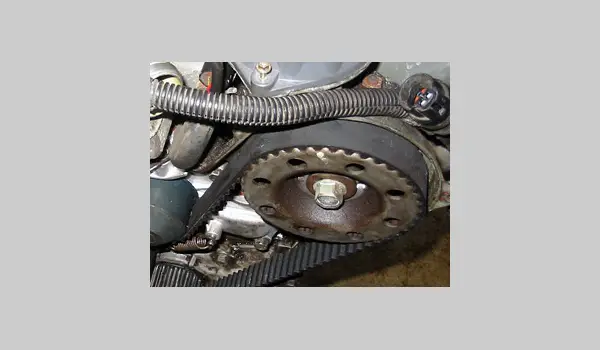
A broken timing belt will cause your 3.0L SOHC Chrysler car or mini-van to crank but not start.
Thankfully, the 3.0L SOHC is not an interference engine, which in plain English means that if the timing belt breaks (while the engine is running) there's no danger of bent or broken valves.
This tutorial I'm gonna' show you two ways to test your 3.0L SOHC V-6 equipped Chrysler vehicle for a broken timing belt.
Contents of this tutorial:
Symptoms Of A Broken Timing Belt
The most obvious symptom that the timing belt broke, on your 3.0L V-6 equipped Chrysler car or mini-van, is that the engine won't start. It'll crank, but no start.
If the engine is running, like when you're driving, and the timing belt breaks, the engine is suddenly gonna' stop and it's not going to restart.
Here are a couple other symptoms:
- You won't see any spark created or delivered to the spark plugs, since the distributor rotor will not turn.
- The fuel injection computer will not pulse (activate) the fuel injectors (since the crank/cam position sensors are inside the distributor).
- If you were to do an engine compression test, none of the engine cylinders would produce a compression reading on the compression tester.
TEST 1: Check Rotation Of Distributor Rotor

The fastest and easiest way to confirm a broken timing belt is checking to see if the distributor rotor turns when the engine is cranking (specially because the distributor is very accessible on the 3.0L SOHC engine).
This test works because the distributor is indirectly driven by the timing belt. So, when the timing belt breaks, the distributor rotor is not gonna' turn.
NOTE: The battery should be fully charged to crank your 3.0L Chrysler car or mini-van. Also, since you'll be working around a cranking engine, be careful, be alert and take all necessary safety precautions.
OK, this is what you need to do:
- 1
Remove the distributor cap but do not remove the distributor's rotor.
- 2
Disconnect the distributor's electrical connectors.
This is super important because the ignition coil must be disabled. The ignition coil must not spark during the test or you run the risk of damaging it, so by disconnecting the distributor's connectors, you effectively disable the ignition coil. - 3
Now, when you're ready, have a helper crank the car or mini-van while you observe the distributor's rotor.
- 4
What will happen is one of two things:
1.) The distributor rotor will turn as the engine cranks in a steady circular motion.
2.) The distributor rotor will NOT turn as your helper cranks the engine.
Let's examine your test result:
CASE 1: The distributor rotor turned. This is a clear indication that the timing belt on your 3.0L SOHC V-6 Chrysler (Dodge/Plymouth) is not broken.
Now, since your 3.0L SOHC V-6 equipped Chrysler doesn't start, I suggest testing the following:
- Check fuel pressure. This will test to see if the fuel pump is working.
- Check for a blown head gasket.
- Check the crank position sensor.
CASE 2: The distributor rotor DID NOT turn. This indicates that the timing belt is broken and not turning the cam gear, which in turn is not turning the distributor rotor.
TEST 2: Check Rotation Of The Cam Gear

If you need further proof that the timing belt is busted on your car or mini-van, the next step is to remove the top timing cover for bank 2 cylinder head.
Bank 2 is the cylinder head nearest the radiator and the cylinder head for cylinders 2, 4, and 6.
OK, this is what you need to do:
- 1
Remove the plug that's covering the hole on the top timing belt cover.
Remember, don't stick anything in there to sense the motion of the cam gear. - 2
Now, have a helper crank the engine as you eyeball the cam gear.
- 3
What will happen is one of two things:
1.) You'll see the cam gear turning.
2.) The cam gear is not gonna' be turning.
Let's see what your test result means:
CASE 1: If the cam gear turned. This is a clear indication that the timing belt on your Chrysler (Dodge, Plymouth) is not broken.
Since your vehicle is still not starting, I recommend checking the following:
- Check fuel pressure. This will test to see if the fuel pump is working.
- Check for a blown head gasket.
- Check the crank position sensor.
CASE 2: If the cam gear DID NOT turn. This indicates that the timing belt is broken and not turning the Cam gear.
You've now confirmed that the timing belt is the cause behind your car or mini-van's cranks but does not start condition.
Where To Buy The Timing Belt And Save Money
When replacing the timing belt, it's suggested that you also replace the water pump and the timing belt tensioner pulley.
Your local auto parts store sells everything you need but it's probably a good idea to comparison shop online.
You can compare prices, by following the links the bottom of this paragraph. Once you get to the site, they will make sure if the timing belt kit fits your specific vehicle or not. If it doesn't they'll get you the right parts at the right price!
Check it out for yourself!
More 3.0L Chrysler Tutorials
You can find a complete list of tutorials in this index: Chrysler 3.0L Index Of Articles.
- How To Replace The Distributor (1988-2000 3.0L Chrysler).
- How To Test Engine Compression (1987-2000 3.0L Chrysler).
- How To Test The MAP Sensor (1991-1995 3.0L Chrysler).
- How To Test The Throttle Position Sensor (1991-1995 3.0L Chrysler).
- Ignition Distributor System Tests 3.0L Chrysler, Dodge, Plymouth (at: easyautodiagnostics.com).

If this info saved the day, buy me a beer!




